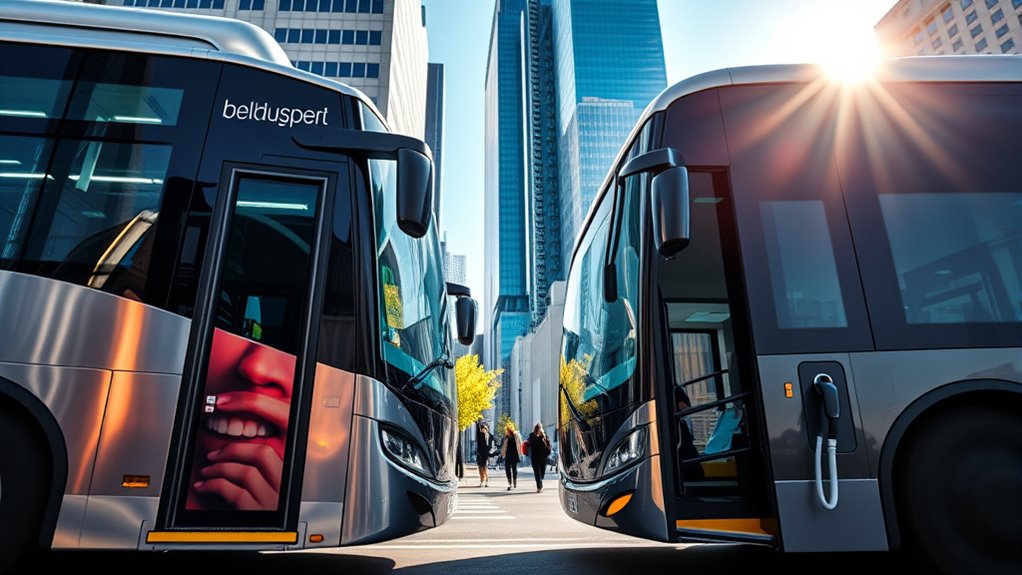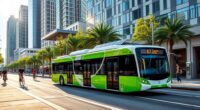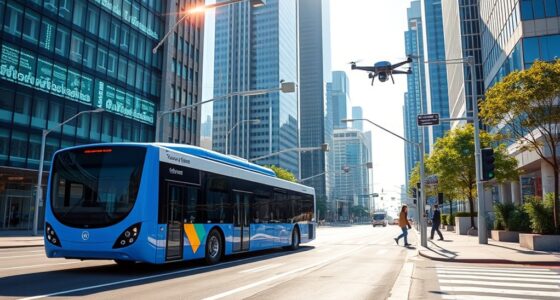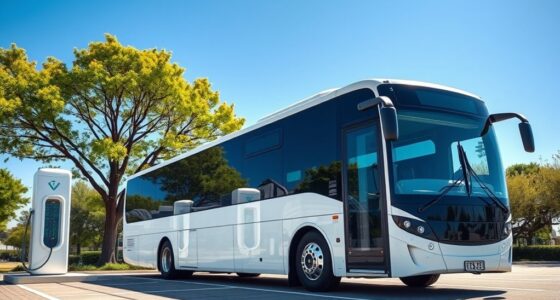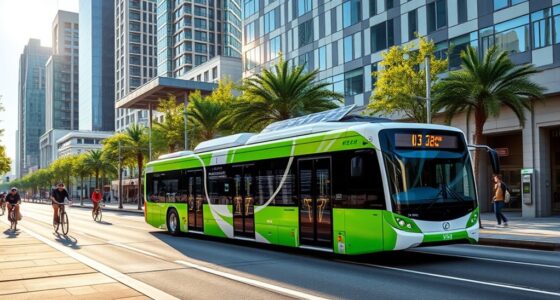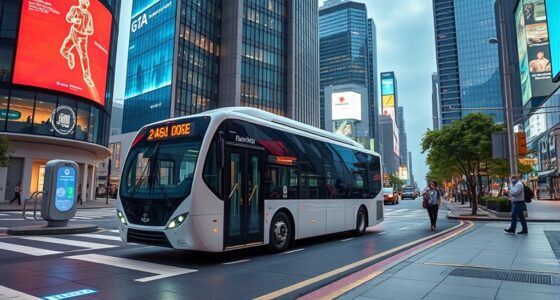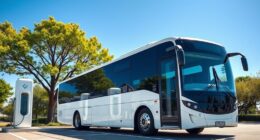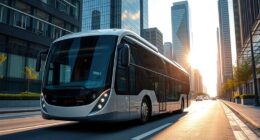Hydrogen fuel cell buses offer longer ranges and quick refueling, making them ideal for extensive routes, while battery electric buses are more efficient and produce zero emissions but face limitations in range and charging time. Costs and infrastructure are challenges for hydrogen, but advancements are helping reduce these hurdles. Both technologies are evolving rapidly, and understanding their differences can help you see their future potential—stick around to explore how each could reshape transportation.
Key Takeaways
- Battery-electric buses are highly efficient (85-90%) with zero tailpipe emissions, ideal for urban routes and short distances.
- Hydrogen fuel cell buses offer longer range and quick refueling (~10 minutes), suitable for extensive routes and high-demand transit.
- Electric buses face limitations in extreme weather and range, while hydrogen buses require specialized, costly refueling infrastructure.
- Total ownership costs over 15 years are higher for hydrogen buses (€394,800 more), mainly due to fuel and infrastructure expenses.
- Advances in technology and infrastructure development are expected to improve the feasibility and competitiveness of both hydrogen and electric buses.

As cities seek cleaner transportation options, hydrogen fuel cell buses and battery electric buses emerge as leading contenders. Both are promising solutions for reducing emissions and modernizing public transit, but they differ substantially in efficiency, infrastructure, and operational flexibility. Understanding these differences helps you decide which technology best fits your city’s specific needs.
Battery-electric buses boast an efficiency of about 85-90%, meaning they convert a high percentage of stored electricity into usable power. They rely solely on electricity, which can be generated from renewable sources, making them highly environmentally friendly. Their zero tailpipe emissions produce only water vapor, aligning with cities aiming to cut pollution. Additionally, advances in battery technology are continually improving energy density and charging speed, making electric buses more practical for various routes. The development of charging infrastructure is essential for supporting widespread adoption and operational efficiency.
Battery-electric buses are highly efficient, converting 85-90% of stored electricity into usable power with zero tailpipe emissions.
However, their energy loss during conversion and seasonal temperature sensitivity can affect performance, especially in extreme weather. While batteries store energy efficiently relative to their weight, they tend to lose some energy as heat during charging and discharging cycles. This impacts overall efficiency, but their high tank-to-wheel efficiency generally results in lower energy costs per kilometer, especially when powered by renewable electricity. Moreover, the integration of smart grid technologies can optimize energy use and charging schedules, further enhancing efficiency.
Hydrogen fuel cell buses, on the other hand, convert hydrogen and oxygen into electricity with an efficiency of about 60-70%. They can store more energy per weight than batteries, making them suitable for limited space scenarios and longer routes. Hydrogen produces only water and heat as byproducts, making it an environmentally clean fuel. Moreover, hydrogen’s high energy density allows for longer operational ranges without frequent refueling.
Furthermore, hydrogen fuel cells are more efficient at converting stored energy and can store surplus renewable energy, supporting energy grid stability. They also offer faster refueling times—around 10 minutes—comparable to traditional diesel buses, which is a notably advantage for high-frequency or long routes. The development of specialized hydrogen refueling infrastructure is crucial for supporting widespread adoption, although it remains more costly and complex to establish. Operating costs for hydrogen buses include higher fuel expenses, with hydrogen costing between €10 and €14 per kilogram, and fuel expenses are about 70% higher than electric equivalents.
When it comes to costs, hydrogen buses tend to be more expensive upfront—about 17% higher purchase prices—and their total ownership costs over 15 years can reach nearly €394,800 more than battery-electric buses. Additionally, their fuel costs are higher, which can impact long-term budget planning. The relatively immature hydrogen infrastructure poses a challenge, but ongoing advancements in hydrogen production methods are expected to reduce costs and improve accessibility. Both technologies are evolving rapidly, with ongoing research aimed at overcoming current limitations and enhancing performance.
Frequently Asked Questions
What Are the Long-Term Maintenance Costs of Hydrogen vs. Electric Buses?
You’re wondering about the long-term maintenance costs of hydrogen versus electric buses. Hydrogen buses tend to have higher lifetime maintenance costs, around €257,000, mainly due to propulsion system expenses.
Electric buses, though slightly more costly over their lifespan at about €270,000, generally have lower overall costs because of cheaper fuel and better efficiency. This makes electric buses more economical in the long run, especially as technology advances and infrastructure costs decrease.
How Do Fueling Times Compare Between Hydrogen and Electric Bus Charging?
Oh, the race of fueling times—who wins? Hydrogen buses charge faster, taking about 12-15 minutes to refill, like a quick coffee break.
Electric buses, on the other hand, need 3-5 hours for a full charge, unless you’re into rapid charging, then it’s around an hour.
What Infrastructure Investments Are Required for Hydrogen Bus Deployment?
You’ll need substantial infrastructure investments for hydrogen bus deployment, including building specialized fueling stations with safety equipment.
California plans to develop around 100 public hydrogen stations, supported by significant funding like the GGRF and statewide budget allocations.
These stations are scalable, supporting fleet growth without frequent new builds.
You’ll also require regulatory compliance, public-private partnerships, and safety standards to guarantee efficient, safe, and environmentally friendly hydrogen fueling for buses.
Are There Safety Concerns Unique to Hydrogen Fuel Cell Buses?
Did you know hydrogen is highly flammable, with leaks potentially causing explosions if not properly ventilated? You should be aware of unique safety concerns like cryogenic risks, such as cold burns from liquid hydrogen, and the need for advanced detection systems.
Proper ventilation is essential, especially in enclosed spaces. These risks require strict safety protocols, making hydrogen bus operation more complex compared to other fuel types.
How Do Lifecycle Emissions of Both Bus Types Compare?
You’re wondering how the lifecycle emissions of hydrogen fuel cell buses compare to battery electric buses.
Hydrogen buses, especially when produced using blue hydrogen, can cut emissions by around 54% over diesel, but they often consume more energy due to production processes.
Battery electric buses generally emit fewer lifecycle emissions—about 17% less than diesel—especially if charged with renewable energy.
Both are cleaner than fossil fuels, but their total impact depends on energy sources and production methods.
Conclusion
As you compare hydrogen fuel cell buses to battery electric buses, consider which option best fits your needs for efficiency, range, and sustainability. Will you choose the quick refueling and longer range of hydrogen, or the simpler infrastructure of electric buses? Both have their strengths, but the decision ultimately depends on your specific transportation goals. So, which technology will drive your fleet into the future? The choice is yours—are you ready to make it?
